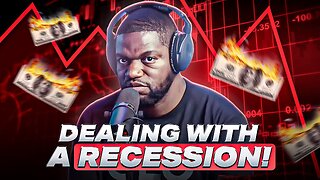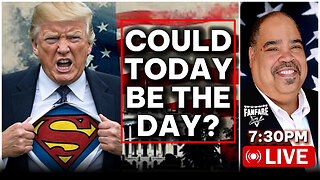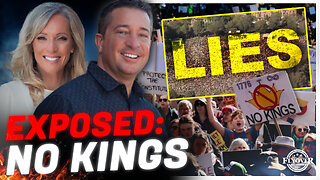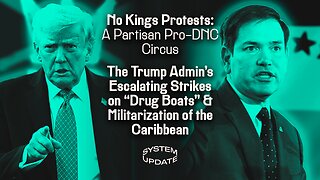Premium Only Content

Episode 2999: Christ the King: Rejecting False Ecumenism and Zionism - Part 1
Welcome to another episode of Tradition Restored, where we stand firm in the unchanging truth of the Catholic faith. Today, we will discuss the necessity of focusing on Christ the King, rather than embracing the false ecumenical movement that seeks to unite all religions at the expense of truth. We will also expose how modern ecumenism has empowered Zionist leaders of Israel while dismissing Christ as the true Messiah.
There are many Protestant churches that support Zionism (the rebuilding of the Temple in Jerusalem and the coming of the Messiah) How as what they profess to be “Christians” can they support either. Would they not be dismissing Christ in the process? Now I did a previous episode on Zionism and its founder and what the real goal is but I want to take it a step further and provide you with one Protestant minister Pastor John Hagee, a prominent evangelical preacher, and contrast him with a great Catholic saint St. Robert Bellarmine, a Doctor of the Church, regarding their views on the origins of the Messiah and the Antichrist.
1. Pastor John Hagee’s Position:
Pastor Hagee, like many evangelical Protestants, promotes Christian Zionism and often assert that the Messiah (Jesus Christ) was Jewish and came from Israel, which is in line with Catholic and biblical teachings.
Hagee wrote:
"Jesus did not come to earth to be the Messiah" and that "the Jewish people, as a whole, did not reject Jesus as Messiah; it was Jesus who refused to be their Messiah."
This statement led many to accuse him of supporting a form of dual-covenant theology the idea that Jews do not need to accept Jesus because they have their own covenant with God. However, Hagee later clarified that he does believe Jesus is the Messiah and that salvation is through Christ alone but that Jesus' earthly ministry was not aimed at establishing Himself politically as the Jewish Messiah in the way they expected.
His stance remains controversial, especially among traditional Christians who affirm that Jesus is the only Messiah for both Jews and Gentiles.
However, when discussing the Antichrist, he often subscribes to the belief that the Antichrist will come from a revived Roman Empire, sometimes suggesting that he could be of European descent. Some evangelicals also claim the Antichrist may arise from the Middle East or even be a Muslim figure.
2. St. Robert Bellarmine’s Position:
St. Robert Bellarmine, a Catholic theologian of the Counter-Reformation, taught extensively about the Antichrist in his writings. He strongly held that:
• The Messiah (Jesus Christ) was of the lineage of David, fulfilling the Old Testament prophecies.
• The Antichrist will be a Jew, coming from the tribe of Dan, and will deceive the Jews into believing he is their Messiah.
• He argued against Protestants of his time who claimed that the Pope was the Antichrist, refuting their errors by proving that the Antichrist will be an individual man, not an institution.
Key Contradictions:
1. Origin of the Antichrist
o Pastor Hagee leans toward the revived Roman Empire theory (possibly European or Middle Eastern).
o St. Bellarmine holds that the Antichrist will be Jewish, from the tribe of Dan.
2. Role of the Antichrist
o Pastor Hagee, like many Protestants, often focuses on the Antichrist as a political figure who will deceive the world.
o St. Bellarmine, in contrast, emphasizes that the Antichrist will lead Jews astray by falsely presenting himself as their long-awaited Messiah.
Pastor Hagee's teachings are rooted in Protestant dispensationalism, which differs from the traditional Catholic eschatology taught by St. Robert Bellarmine. While both agree on the existence of an Antichrist, they contradict each other on his origins, with Bellarmine maintaining the Jewish Antichrist theory and Hagee leaning toward a Roman/European/Middle Eastern figure.
Now for the 800lb Gorilla in our proverbial Catholic Church that leads to a very uncomfortable question. Did Vatican II and now Pope Francis attempt unseat Christ in order to create a one world government and move away from the mystical body of Christ (Catholic Church)
From a traditional Catholic perspective, many have raised concerns that Vatican II and the modern papacy, particularly under Pope Francis, have significantly altered the Catholic Church’s mission and identity in ways that appear to undermine Christ’s Kingship and the doctrine of the Mystical Body of Christ (which is the Catholic Church itself).
1. Vatican II’s Role in Weakening the Church’s Identity
The Second Vatican Council (1962-1965) introduced reforms that shifted the Church’s focus from its exclusive role as the one true Church of Christ to a more ecumenical and interreligious approach. Some key changes include:
• Lumen Gentium (1964) – Instead of affirming that the Catholic Church is the Mystical Body of Christ, it introduced the ambiguous phrase that Christ’s Church “subsists in” the Catholic Church, allowing room for non-Catholic groups to be considered part of the Church.
• Nostra Aetate (1965): Opened the door to interreligious dialogue, leading to what some view as a false unity with non-Christian religions.
• Religious Liberty (Dignitatis Humanae, 1965): Reversed the Church’s traditional teaching that Christ’s Kingship should be the foundation of society, replacing it with a Masonic-style separation of Church and State.
These changes led many traditionalists (such as Archbishop Marcel Lefebvre) to argue that Vatican II intentionally de-emphasized the Catholic Church’s role as the Mystical Body of Christ in favor of a humanist, globalist vision.
2. Pope Francis’ Actions and the Push Toward a One-World Religion
Pope Francis has continued and accelerated Vatican II’s ecumenical agenda, moving even further away from the traditional understanding of the Mystical Body of Christ:
• The Abu Dhabi Document (2019): Pope Francis signed an agreement stating that God wills the diversity of religions, which contradicts Christ’s words: "I am the way, the truth, and the life: no man cometh to the Father, but by me." (John 14:6).
• The Synodal Process: Introduces relativism and democratic decision-making into the Church, contradicting the traditional hierarchical structure.
• Pachamama Idolatry (2019): Allowed the worship of the pagan goddess Pachamama in St. Peter’s Basilica, which many viewed as an attempt to merge Catholicism with pagan, earth-worshiping spirituality.
• Climate Change and Social Justice Focus: The Pope’s emphasis on globalist policies, environmentalism, and economic equity aligns closely with the goals of organizations like the United Nations and World Economic Forum, raising concerns that the Church is being used to promote a one-world government rather than Christ’s Kingship.
3. Is This an Attempt to “Unseat” Christ?
From a traditional Catholic standpoint, the changes stemming from Vatican II and Pope Francis’ actions appear to:
1. Weaken the authority of Christ the King in society (by promoting religious pluralism instead of Catholic social kingship).
2. Blur the distinction between the Catholic Church and other religions, leading toward a false unity that is not centered on Christ.
3. Align the Church with globalist political structures, shifting focus away from salvation and toward earthly concerns like climate activism, social justice, and economic restructuring.
Many traditionalists argue that this fits into the prophecies of apostasy, where a false Church would arise to pave the way for a one-world government and a counterfeit religion, in opposition to Christ’s Mystical Body.
Conclusion
While Vatican II and Pope Francis may not have explicitly stated that their goal is to unseat Christ, their actions de-emphasize Christ’s Kingship and weaken the Church’s role as the one true faith. This shift directly contradicts traditional Catholic teaching and raises serious concerns about whether the Church’s leadership is preparing the way for a secular, one-world government rather than upholding the reign of Christ the King.
-
 1:00:31
1:00:31
FreshandFit
12 hours agoWe Are In A Recession...Do This Now!
64.1K25 -
 LIVE
LIVE
Side Scrollers Podcast
1 day ago🔴SIDE SCROLLERS FUND-A-THON🔴DAY 1🔴100% REVENUE HELPS CHANGE CULTURE!
1,123 watching -
 3:03:39
3:03:39
Barry Cunningham
11 hours agoPRESIDENT TRUMP HAS A MAJOR WIN AND HIS TEAM IS ABSOLUTELY UNLEASHED!
78.4K39 -
 58:59
58:59
Flyover Conservatives
1 day agoThe Agenda Behind No Kings — They Lied. They Funded It.; Silver Explosion FAR from Over, PhD Explains What’s Next and Why! - Dr. Kirk Elliott | FOC Show
57.2K9 -
 1:55:03
1:55:03
We Like Shooting
20 hours ago $13.43 earnedWe Like Shooting 633 (Gun Podcast)
43.8K -
 1:32:29
1:32:29
Glenn Greenwald
12 hours agoNo Kings Protests: A Partisan Pro-DNC Circus; The Trump Admin's Escalating Strikes on "Drug Boats" and Militarization of the Caribbean | SYSTEM UPDATE #534
137K95 -
 3:49:31
3:49:31
SOLTEKGG
10 hours ago🔴LIVE - BATTLEFIELD 6 W/ SOLTEK
51.6K1 -
 3:46:40
3:46:40
VapinGamers
9 hours ago $4.10 earnedBattlefield 6 - Gettin My Body Ready for BR and Other Funzies with Friends - !rumbot !music
41.3K -
 41:43
41:43
MattMorseTV
11 hours ago $45.88 earned🔴It’s ACTUALLY HAPPENING…🔴
54.2K114 -
 4:34:30
4:34:30
Putther
9 hours ago $3.41 earned🔴LIL WILLY RETURNS TO GTA RP
25.2K